I remember Gerry Lazare telling me that it took Fred Kelly over a year of having his art repeatedly critiqued and rejected by Bell Features’ Art Director Adrian Dingle before Dingle allowed one of Kelly’s stories to be published. Well, I’m sure that Ed Shecter had a comic book heart, but his artwork and most of his storytelling never progressed beyond a level I remember seeing at the beginning of comic fandom in a few good-intentioned 1960’s fanzines. Still, Adrian Dingle somehow did accept Shecter’s crude rendering of the three “Marvo, the Espionage Agent” stories that appeared in Joke Comics Nos. 8, 9, and 10?
Israel Schachter was born in Toronto in 1926 but preferred using the name Edward Shecter. His parents had originally come from Russia to Canada in 1906 and became naturalized Canadians in 1911. He must have just turned 17 and still in high school when he submitted his Marvo work to Bell Features in the late Spring of 1943. It was the middle of the war and, with many of his artists drafted or leaving for the U.S., Dingle was probably hungry for filler for Bell Features’ line of seven comic book titles. Perhaps this was why he was bringing teen-aged kids like Jerry Lazare, Ross Mendez, Aram Alexanian, and Ed Shecter on board around this time.
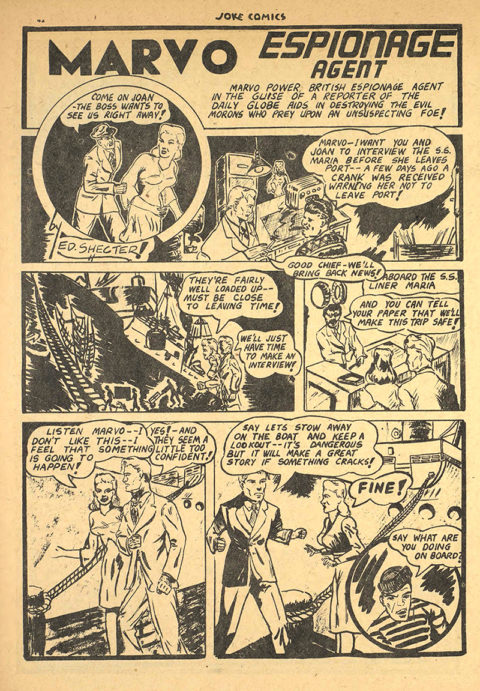
Shecter’s feature character was Marvo Power who worked for the British Intelligence Office and had the cover of a day job as a reporter for the Daily Globe newspaper. His first appearance was in Joke Comics No. 8 where, accompanied by female reporter co-worker/nuisance Joan, he foils a Nazi fifth column agitator who had infiltrated the crew of the cargo ship S.S. Maria. In his second appearance, in Joke Comics No. 9, Marvo captures the Nazi gang who had assassinated the leader of a Victory Bonds campaign. Marvo’s final Bell Features appearance was in Joke Comics 10, and, in this issue, he does nothing short of crossing the English Channel and stealing Nazi plans to invade England. Strangely, in this last story, co-reporter Joan becomes Jane Hawkins. Each of these stories was only three pages long and seemed to signal an audition for Bell Features that didn’t pan out. This was the early fall of 1943 and Ed Shecter didn’t surface again in comics until the summer of 1945.
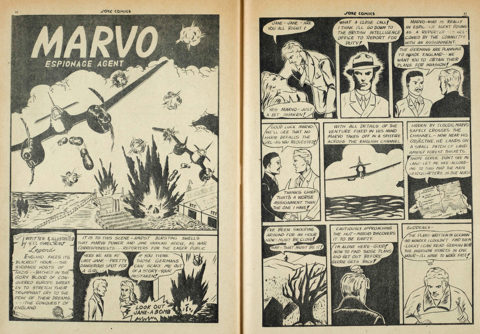
Just after VE Day, in the early summer of 1945, Toronto pulps publisher Rucker Publications decided to get into comics with its new title Weekender Illustrated News Review.
The cover for the first issue was a slight redraw of the cover of MLJ’s Zip Comics No. 45, and its core content comprised an insert of about a dozen pages of newspaper type columns and photos concerning news from around the Toronto area as well as black-and-white reprints of some of the content from that Zip Comics No. 45.
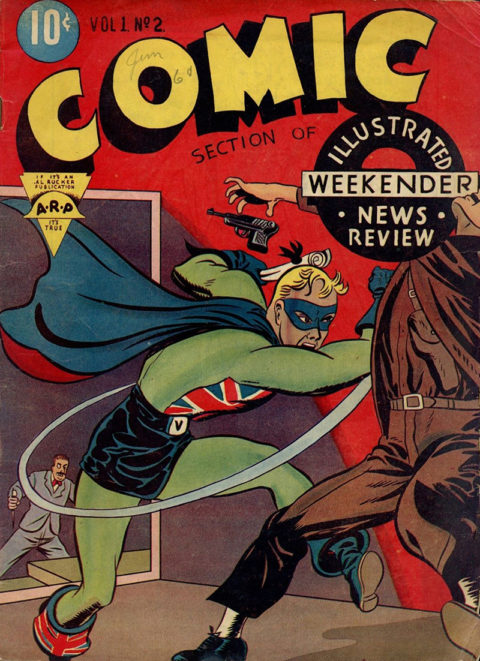
However, with the second issue, Rucker decided to go with some new material in the comics section and called on Ed Shecter who supplied three features for this issue. One of these features was another three-page Marvo instalment in which Marvo takes on a Japanese mastermind behind a crime wave.
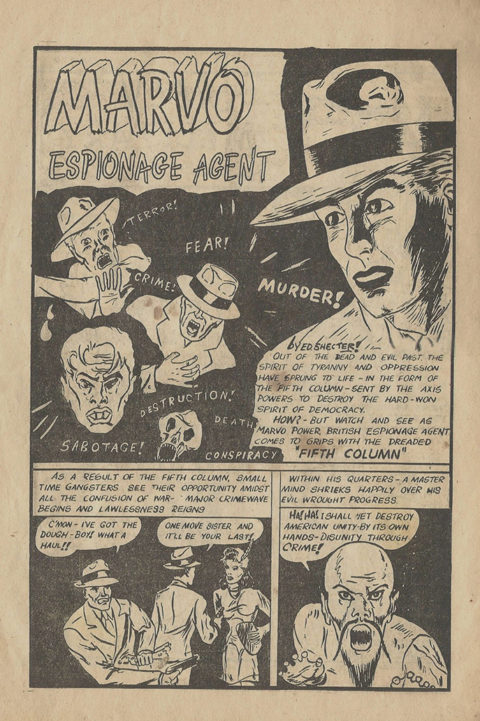
The second was titled “Hank Wilson” and was about a famous American professional baseball player who joined Marines and flew a plane in the Pacific theatre. The last was a superhero feature entitled “Captain Victory with Rocky the Young Ally” and it was this hero, decked out in his Union Jack breastplate, who made the cover of the issue. The cover artist certainly wasn’t Ed Shecter. It looks to me to have been drawn by Harold Bennett who did the cover for Rucker’s United Nations War Heroes and probably the cover for the same company’s United Nations Battle Heroes.
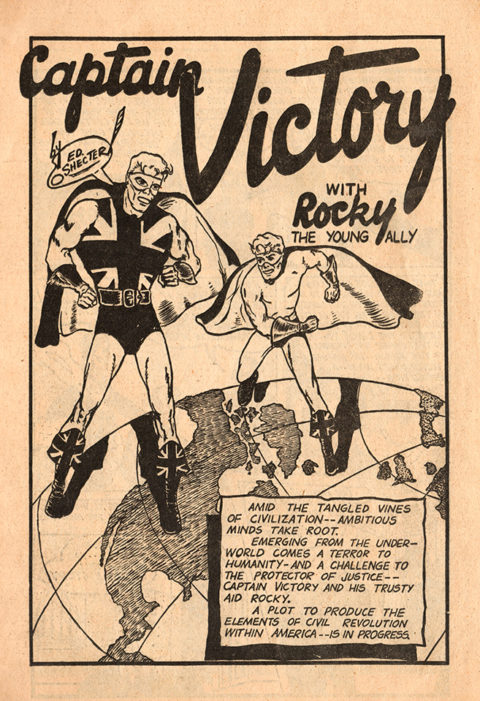
The Captain Victory story is of significance because, at ten pages, it is Shecter’s longest feature, and also because there is a palpable irony and slight incongruency in the fact that it is a Union Jack-clad hero who steers America away from a home front civil war. The story begins with a Nazi representative named Professor Picklegruber addressing a council of Allied leaders with the claim that he has unearthed a long lost document from 1776 about property rights in America that, if made public, would start a civil war. He demands ten billion dollars by noon the next day to keep things quiet. Private detective Perrie Stirling and his assistant Rocky Ryan, who are secretly Captain Victory and sidekick Rocky, get wind of the situation and arrange for a meeting of American political party officials to sign a document would counter that 1776 document.
Picklegruber manages to disrupt that signing by shooting one of the officials and then escaping. Captain Victory tracks Picklegruber down but the Nazi agent swallows suicide pills and civil war still looms.
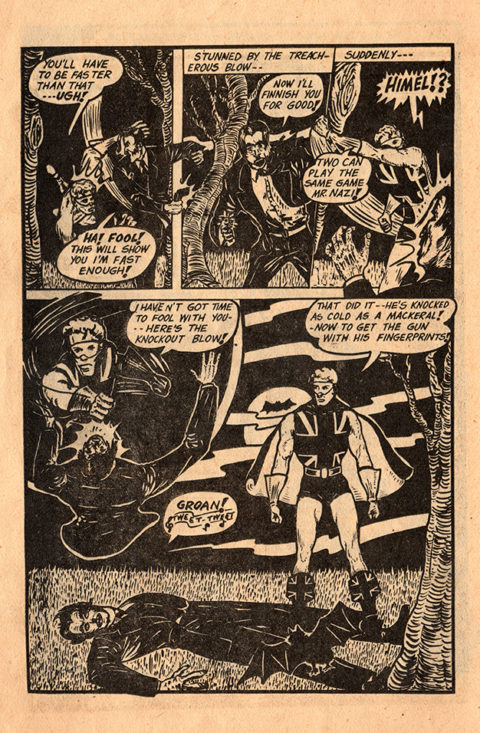
Luckily, the official who was shot recovers in hospital, the signing is completed resulting in Captain Victory and Rocky saving America’s bacon.
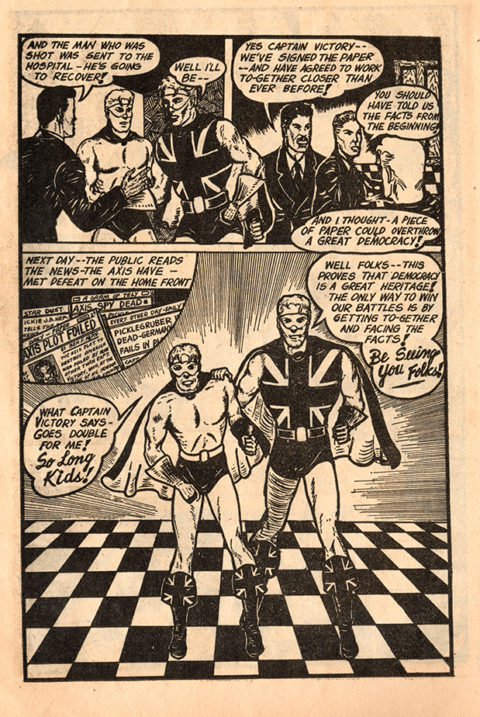
Just about the same time that Shecter was working on that second issue of The Weekender, he was also starting up his own Canadian comic book publishing company called Feature Publications, whose offices were located on the south-east corner of Spadina Avenue and Harbord Street in Toronto. Today, this is just on the edge of the University of Toronto.
The total output of Feature Publications was a three-issue run of a title called Lightning Comics which curiously began with issue No. 10. Lightning Comics No. 10 has a cover date of August-September but no year in the indicia. I originally thought the book was from 1944 but, after examining the run more closely, it has to be 1945. For example, the final two-page filler in issue 10 is about a group of college kids who are trying to put out their annual magazine. When the magazine is pictured in the penultimate panel the date on it is 1945. Also in issue 11, the Captain Daring story is specified as set in present of September 12, 1945, and the Don Swift story from that issue announces the surrender of the Japanese due to the use of the Atomic Bomb.
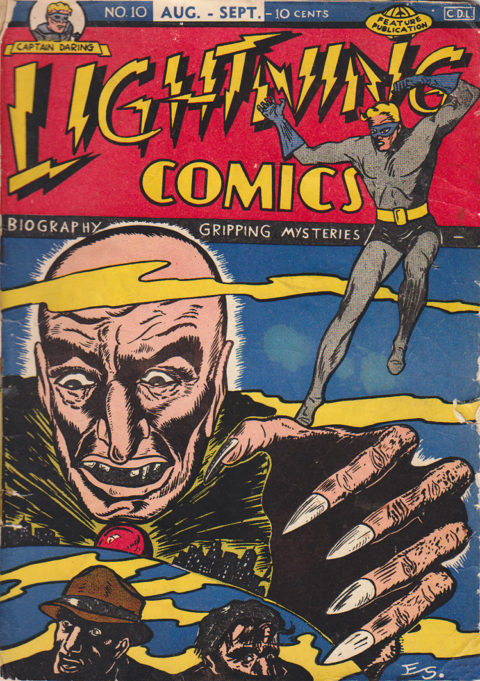
Lightning Comics No. 10 was probably on the stands alongside the six Bell Features one-shot compendiums including the painfully desirable Nelvana compendium. The lead-off feature and the cover subject is Shecter’s new costumed creation, Captain Daring.
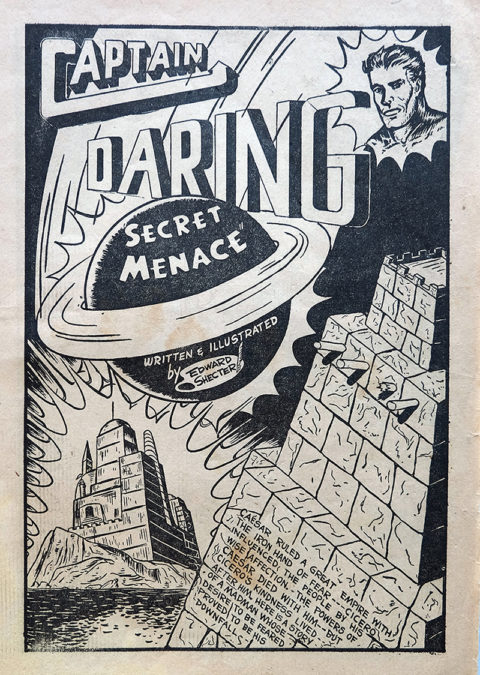
Shecter never gives us an origin story and the Captain’s power spectrum isn’t clear, but all evil doers seem to fear him. Captain Daring does have an Auto-Gyro which is a special, advanced aeroplane with a large helicopter rotor on top of the fuselage. The villain in this story is a former Nazi General (another clue that this is post-VE Day 1945) who has managed to hide away on a remote island and is now preparing to dominate the world by using an invention stolen from a scientist. Captain Daring foils the plot with his fists and dispatches the villain over the balcony of a building, and then departs in his Auto-Gyro to the thanks of the islanders.
Next is a story about a fictional Squadron Commander in the European air war entitled, “Flash Fulton of the Wildcat Squadron,” with Shecter’s initials on the splash page.
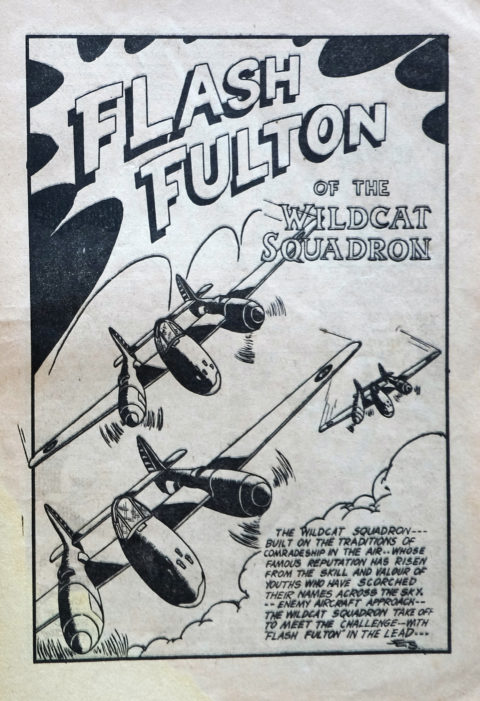
It’s a little disappointing that the markings on the planes in Flash’s squadron are American, but this seems to be a common trend in Shecter’s stories. Flash uses his flying skills and daring to save his own base from being bombed and is then recruited by the Base Commander to lead a raid on German robot plant. In the final panels, his plane is disabled by a German surprise attack and looks to be in a death dive.
From a superhero and an air ace, the comic moves on to a story about underground resistance in occupied France. This splash page has the title “The Thatcher Brothers” and a by-line with the name “Ben Bowman,” neither of which are particularly believable.
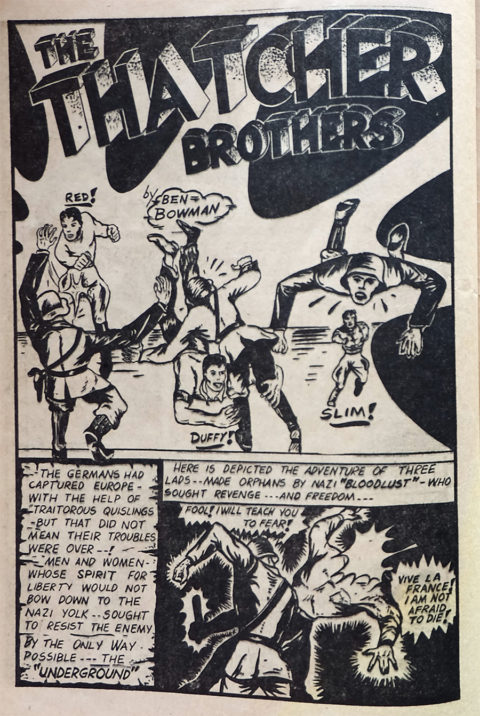
The three Thatcher Brothers, Red, Duffy, and, Slim are supposedly French nationals but they look better placed on some Brooklyn back streets. The brothers have the misfortune of having their father brutally killed in front of them by a Nazi soldier and one of them, Red, immediately retaliates by killing that soldier. This sends them into the underground and sets the scene for future instalments. The by-line, too, is a concoction of Shecter’s because this is clearly his art as well. In fact, all the art in the comic appears to be by Shecter which, again, is a great achievement of comic book enthusiasm, though I don’t think it could ever be called a tour de force.
Next is a ‘dog story’ titled “Laddie, Watchdog of Nature” with another pseudonymous by-line, “Dickens.” This time the story in the American northwest coast, close to the border with Canada. Laddie and his owner, Jack Lawrence, do no less than ‘single-doggedly’ capture a pair of escaped Nazi prisoners along with the U-Boat that comes close to shore to retrieve them.
The issue has two more features: “The Daredevil Commando’s ” (Shecter’s grammar) about a group of commandos who destroy a German pillbox, and “Don Swift (R.C.A.F. Patrol)” about a Canadian air ace based in southern China who is sent to rescue a Chinese agent from a Japanese prison camp.
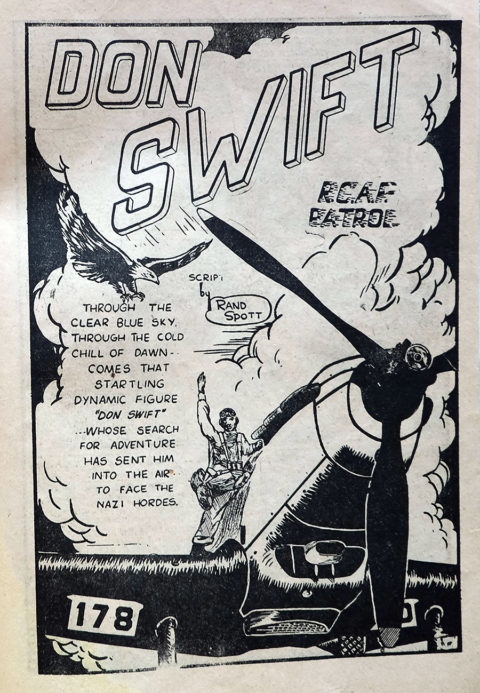
Lightning Comics No. 11 (cover date Oct.-Nov. of 1945) also leads of with a Shecter Captain Daring story titled “Captain Daring and the Vanishing World (The Search-Light of Lonesome Towers). It begins in 1940 with some grease on a cliff road that causes the deaths of a scientist and his wife. Captain Daring investigates the next day because the scientist who was killed was one of his old classmates, but he finds no clues. He returns to the scene five years later (on Sept. 10, 1945-again signalling the date of the comic) where he encounters the scientist’s twin brother. He finds out that the scientist had invented a destructive ray called “The Search Light,” and that he was killed in order to steal this invention. The twin takes Captain Daring to the island of Gatooma in the mid-Atlantic where the invention is located atop a building called Lonesome Towers and the episode ends.
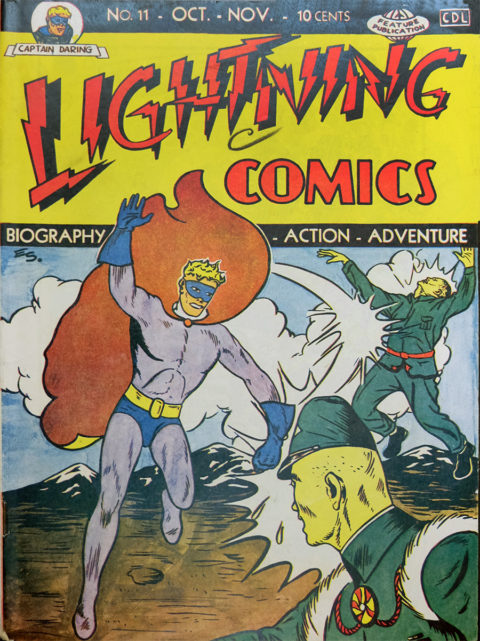
The next story, about the dog Laddie getting into trouble at the circus, is also by Shecter, but the one following is done by none other than Bell Features artist and creator of The Polka-Dot Pirate, Ross Mendes. It’s called “Doctor Future in the Future of Miniature Man” and tells the story of Dr. Benson who is also known as Dr. Future because is always working on future machines.
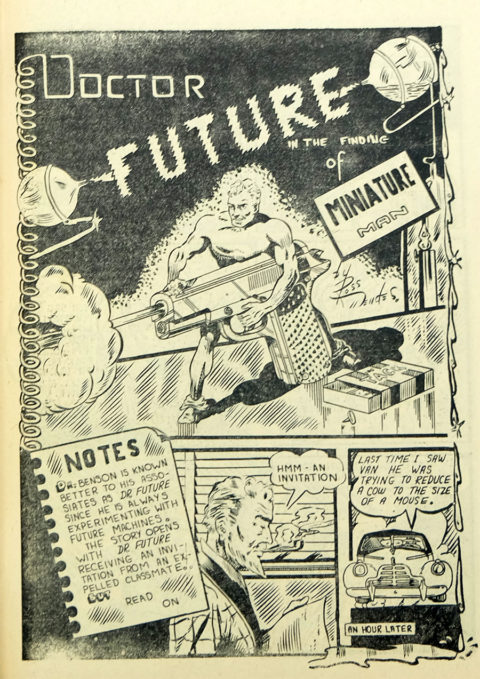
Dr. Benson receives an invitation to visit an old classmate from scientists school who wants to show him his progress on a shrinking ray. The classmate demonstrates his invention by shrinking a volunteer to miniature size and announce that he wants to use this invention to take over the world. When Benson tries to stop him, the evil scientist pulls out a knife but is foiled by the newly created miniature man who then introduces himself as Pee Wee Wilson. Benson supplies Pee Wee with a costume and dons an outfit of his own which has a belt that sends both of them into the 30th century for further adventures.
Following the Doctor Future story is another ‘Don Swift R.C.A.F.’ story this time only with the splash done by Shecter and the rest done by Ross Mendes. The splash panel has Shecter’s initials on it and Ros Mendes’ signature appears on the second-to-last panel of the story. This is followed by a ‘Thatcher Brothers’ story about them making it to America. It lists Ben Bowman as the artist again but this time it’s not Shecter operating under the pseudonym, but Ross Mendes. Then there’s another new feature, ‘The Dartman’ and it’s signed by a D. Haughton about whom nothing is known. Dartman’s skill/power is that he has a gun that fires tiny darts at his enemy. Finally, another ‘Flash Fulton’ air ace story by Shecter closes the issue out.
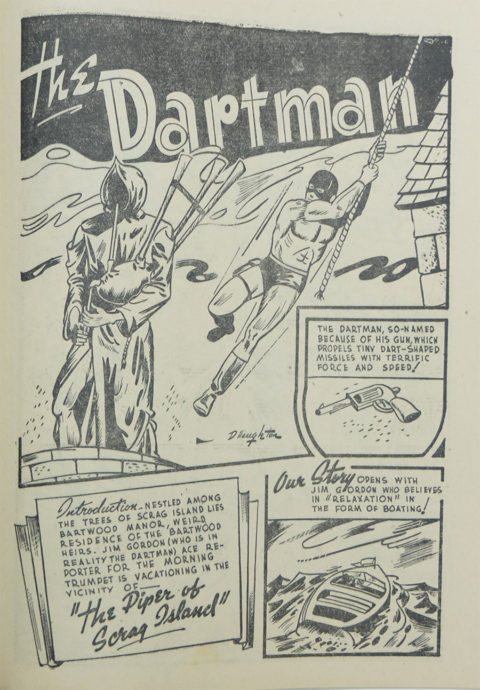
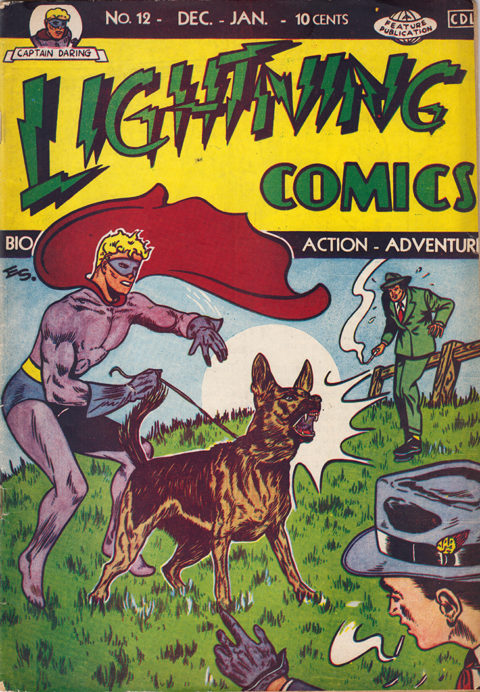
The final issue of the run also leads off with Shecter’s Captain Daring as he encounters a strange race of people from the sky on that island of Gatooma. He also finds out that the twin brother is not a twin at all, but the actual scientist thought to have been murdered in 1940… and things turn sinister. The book also continues with the following features from the first two issues: ‘Laddie’ and ‘Flash Fulton’ by Shecter, ‘Dr. Future and Pee Wee’ and ‘Don Swift’ by Ross Mendes, and ‘Dartman’ which this time looks to be done by Shecter.
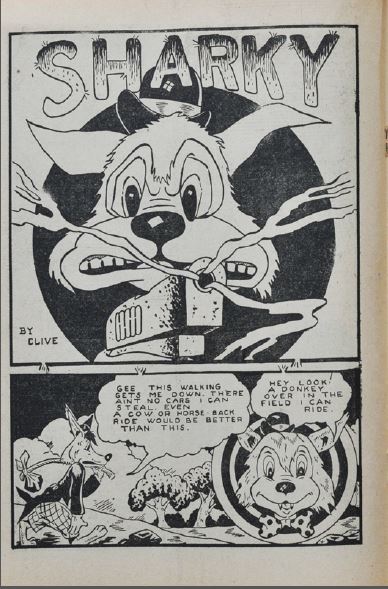
This issue also introduces two new features: funny animal story ‘Sharky’ by an artist named Clive and, what I think is the best feature to appear in the title, Aram Alexanian’s ‘Nemesis and his Wonder Dog, Rover.’
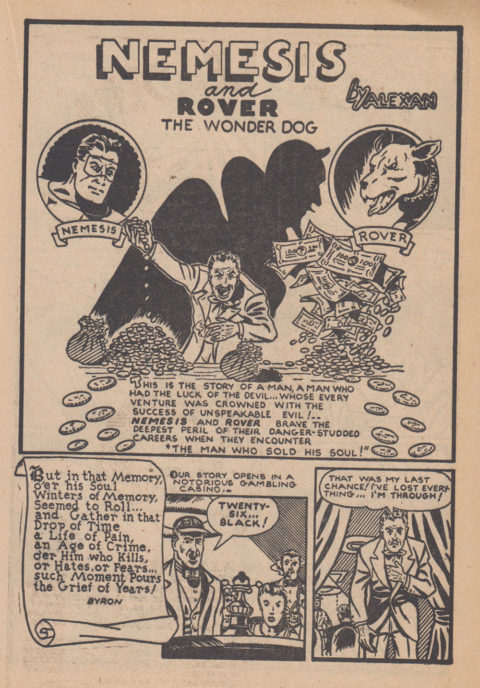
Alexanian was 17 when he did this story about a gambler who sells his soul to the devil. Nemesis and Rover are actually bystanders in the main story and intersect with it when they break up a gambling den owned by the Faust-like victim.
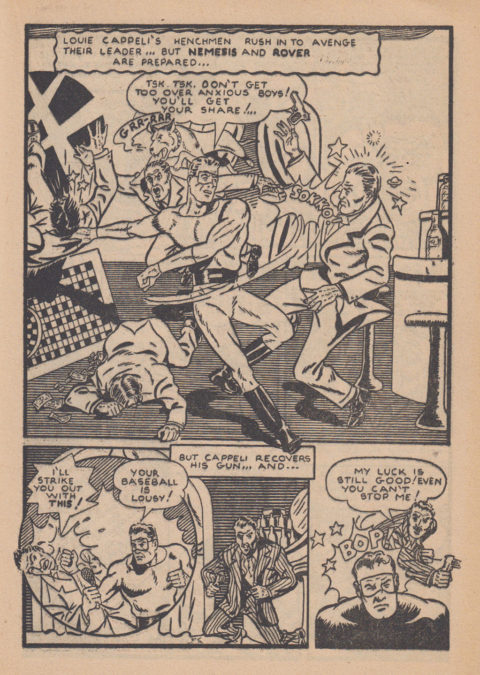
There you have it…. three Marvo stories for Bell Features, another Marvo and a couple of new stories for Weekender No. 2, and the start up of the Features Publications comic company which put out three issues of its lone title: Lightning Comics. A legacy that displays a tremendous enthusiasm for comic creation and love of comics, but maybe without the skills necessary to succeed. Eddy Shecter died on August 12, 1973, at 57 years old. His comic heart shouldn’t be forgotten.
I want to thank Jim Finlay for taking the time to scan the Shecter stories from his copy of Weekender No. 2 during his own very busy schedule. This column wouldn’t be nearly as complete without his help.
NEWS
I, along with Art Cooper and Ron Kasman, will be presenting a panel titled “Canadian Comics and Fandom before Captain Canuck” at Richard Comely’s Tri-City Super Con on Sunday, September 29th at 3:30 PM. Ron will have a floor table both days and will have copies of his new graphic novel, The Geek of the Gods with him for sale. Art and I will be sharing a table both days as well, hoping to flog some of our own goodies. Come by and say ‘hi’ if you are attending.
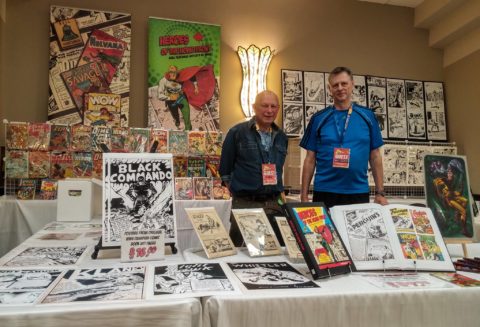

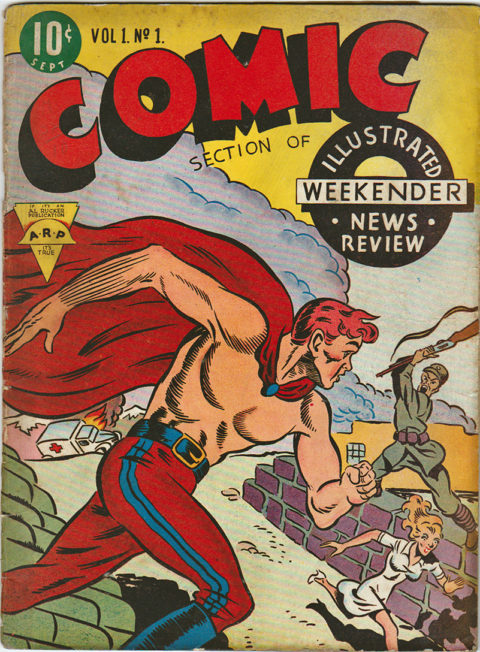
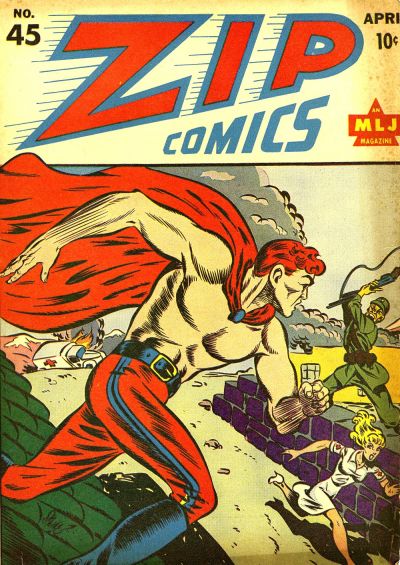



Ivan, thank you for shedding a light on these seldom discussed Whites. I hope you have a good turnout for your display.
“A” for effort on Ed’s part, he may not have been an accomplished comic artist but he did achieve publication. As a kid, I don’t know if it would have mattered to me so much especially in a comic drought. And trying to do a story in three pages, that’d be a challenge any way, either too short or hard to make sense with. Would be a good tryout test for an aspiring artist. Lightning Comics is a great comic title and look how rare it is. Thanks, Ivan, always interesting.
Please DO send me an email or mention here what items you’ll be having at your table at Tri-City. I wouldn’t be able to make it out but would like to support your WECA efforts with purchases of merch like that Black Commando print (and including Ron’s book(s) too, autographed please). I can Paypal or e-transfer. Thank you!
Another obscure comic revealed. As you mention, its interesting how much this work looks like early fan work in the U.S. fanzines of the sixties.
Wow, that is one impressive display for Tri-Cities. I hope you will post a new shot for this year’s exhibit. Also, still hope to hear how the panel(s) went at the Toronto show. Margaret Atwood has sure been getting a ton of coverage lately, now for her sequel to Hand Maid’s Tale. She was on PBS the other night, and in Time Magazine. I hope that increases interest in her two graphic novels.
Tony, thanks for your appreciation. Tim, I’ll contact you by email about some of the stuff we will have on display and I’ll get Ron Kasman to contact you about his books.
Bud, we had just over 50 people in attendance for the panel at Fan Expo Toronto and a couple were dressed up as handmaids. The audience were very engaged and asked a number of good questions. After the panel a few members of the audience came up and said that they never new that we Canadians had our own comics during WWII and why wasn’t there more out about them. A couple that came up said that they were high school history teachers and that these comics would be great way to study the history of Canada and the Second World War. Ken Steacy had gotten Margaret Atwood to sign 40 copies of his War Bears graphic novel. He announced this during the panel and sold out of them right after it. I’ll try to take a pic of our set up this year. It all depends on how much space they give us.
Another great article. It was good to finally learn about the interiors of those Lightning Comics. Been seeing those cover images for years, with no knowledge of the stories.The Captain Victorydesign is interesting.
Sort of “off topic” since there’s no place to make announcements, but related to the column – I bought my first Canadian White…
in colour!
GRAND SLAM Three ACES #50 (1946)! Hurray, I’m in the club!! Arrived on Friday, opened very carefully and glanced over. Plan to read it this week and hope I can scan or photograph it for the archive page at CoC. So fun! So Exciting!
Ivan gets the kudos for setting this path. Don’t know how far I’ll go into it but having one on my shelf is terrific. Thanks!
In this journey to promote our old Canadian WW2 Comics do you think “we” need to upgrade them to today’s framework, ie Marvelizing? I love the old artwork and don’t want to dishonour the creators but Captain Canuck is on his third redesign since 1975. Do Freelance or Nelvana or Brok, etc. need modernized costumes and artwork to make them palatable to the current comic book audience? Thoughts?
I’m planning some original art t-shirts for myself, wondering about attempting an attempt at upgrades. Something I’ll play with in my sketchbooks, might be fun.